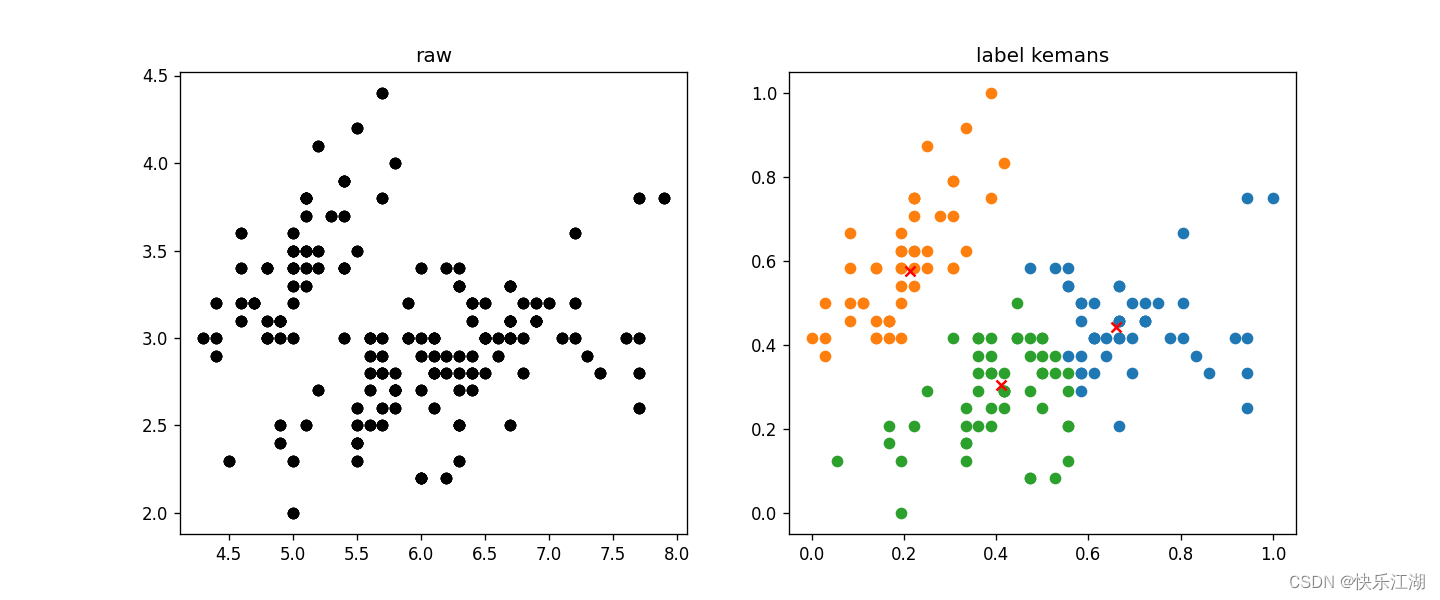一:算法思想
- 硬聚类:传统K-均值算法中,每个对象只能从属于所有类别中的一类,称之为硬聚类。这种聚类方法会带来一个问题:所有的对象对于计算聚类中心的贡献都是相同的,也就是说,对于从属于一个类的所有元素,算法是无法将其区分开来的。这种分配方式在处理一些复杂数据集合(例如数据有重叠)会造成类别指派不合理
- 软聚类:一个对象可以从属于多个类别的聚类方法
模糊K-均值算法(FCM算法):对于每个类别,对象都对应一个取值范围在[0,1]的数值,它表示该对象从属于某一类别的可能性。一个对象对于所有类别的对应取值和应该为1。在更新簇中心点的过程中,该数值就反映了该对象对于这一类的贡献程度,根据贡献程度的不同,反映出对象更倾向于分配到哪个类别中
FCM算法与K-均值算法的目标函数类似
J m = ∑ k = 1 N ∑ j = 1 u i j m ∣ ∣ x i ? c j ∣ ∣ 2 , 1 ≤ m < ∞ J_{m}=\sum_{k=1}^{N}\sum_{j=1}u_{ij}^{m}||x_{i}-c_{j}||^{2},1\leq m <\infty Jm?=k=1∑N?j=1∑?uijm?∣∣xi??cj?∣∣2,1≤m<∞
其中
- m ( > 1 ) m(>1) m(>1):模糊系数
- N N N:样本数
- C C C:聚类中心数
- c j c_{j} cj?:第 j j j个聚类中心
- x i x_{i} xi?:第 i i i个样本
- u i j u_{ij} uij?:样本 x i x_{i} xi?对聚类中心 c j c_{j} cj?的隶属度,也即 x i x_{i} xi?属于 c j c_{j} cj?的概率。显然有 ∑ j = 1 C u i j \sum\limits_{j=1}^{C}u_{ij} j=1∑C?uij?=1
FCM算法通过更新 u i j u_{ij} uij?和 c j c_{j} cj?来迭代优化目标函数
u i j = 1 ∑ k = 1 C ( ∣ ∣ x i ? c j ∣ ∣ ∣ ∣ x i ? c k ∣ ∣ ) 2 m ? 1 u_{ij}=\frac{1}{\sum\limits_{k=1}^{C}(\frac{||x_{i}-c_{j}||}{||x_{i}-c_{k}||})^{\frac{2}{m-1}}} uij?=k=1∑C?(∣∣xi??ck?∣∣∣∣xi??cj?∣∣?)m?12?1?
c j = ∑ i = 1 N u i j m x i ∑ i = 1 N u i j m c_{j}=\frac{\sum\limits_{i=1}^{N}u_{ij}^{m}x_{i}}{\sum\limits_{_{i=1}}^{N}u_{ij}^{m}} cj?=i=1?∑N?uijm?i=1∑N?uijm?xi??
FCM算法的收敛条件一般设置为两次迭代过程中计算的 S S E SSE SSE差值,其中 ξ \xi ξ是预先设定好的容忍误差,当两次迭代过程中计算的 S S E SSE SSE差值小于该预设值时,判定算法收敛
E ( t ) = ∣ ∣ S S E t ? S S E t ? 1 ∣ ∣ < ξ E(t)=||SSE^{t}-SSE^{t-1}||<\xi E(t)=∣∣SSEt?SSEt?1∣∣<ξ
二:算法流程
- 初始化隶属度矩阵 U 0 U^{0} U0:若有 N N N个样本,指定类别个数为 C C C,则隶属度矩阵应为 N N N× C C C
- 根据公式更新聚类中心 c j c_{j} cj?
- 根据公式更新隶属度矩阵(注意保存更新前的隶属度矩阵)
- 判断是否收敛,若收敛则停止迭代,反之返回步骤2
三:Python实现
import numpy as np
import copy
# 欧氏距离
def distance(data, centroid):
return np.sqrt(np.sum(np.power(data-centroid, 2)))
def fcm(data_set, m, k, eps):
example_nums = np.shape(data_set)[0] # 样本数量
cluster = np.zeros(example_nums)
# 初始化隶属度矩阵
random_mat = np.random.rand(example_nums, k) # 生成随机矩阵
random_mat_sum = 1 / np.sum(random_mat, axis=1) # 求每一行的和
membership_mat = np.multiply(random_mat.T, random_mat_sum) # 使隶属度矩阵每一行和为1
membership_mat = membership_mat.T
membership_mat_old = np.zeros((example_nums, k)) # 便于迭代
# 进行迭代,更新隶属度矩阵和聚类中心
while True:
centorids = np.empty((k, np.shape(data_set)[1]))
# 由公式计算簇中心
for j in range(k):
centorids[j] = np.dot(membership_mat[:, j]**m, data_set) / (np.sum(membership_mat[:, j]**m))
membership_mat_old = membership_mat.copy()
# 根据公式计算新的隶属度矩阵
for i in range(example_nums):
for j in range(k):
for z in range(k):
membership_mat[i, j] += ((distance(data_set[i], centorids[j])) / distance(data_set[i], centorids[z])) ** (2 / (m-1))
membership_mat = 1 / membership_mat
# 判断是否收敛
if np.max(np.abs(membership_mat - membership_mat_old)) < eps:
cluster = np.argmax(membership_mat, axis=1)
return centorids, cluste
四:效果展示
import pandas as pd
import matplotlib.pyplot as plt
import FCM
import numpy as np
Iris_types = ['Iris-setosa', 'Iris-versicolor', 'Iris-virginica'] # 花类型
Iris_data = pd.read_csv('dataSet/Iris.csv')
# x_axis = 'PetalLengthCm' # 花瓣长度
# y_axis = 'PetalWidthCm' # 花瓣宽度
x_axis = 'SepalLengthCm' # 花萼长度
y_axis = 'SepalWidthCm' # 花萼宽度
examples_num = Iris_data.shape[0] # 样本数量
train_data = Iris_data[[x_axis, y_axis]].values.reshape(examples_num, 2) # 整理数据
# 归一化
min_vals = train_data.min(0)
max_vals = train_data.max(0)
ranges = max_vals - min_vals
normal_data = np.zeros(np.shape(train_data))
nums = train_data.shape[0]
normal_data = train_data - np.tile(min_vals, (nums, 1))
normal_data = normal_data / np.tile(ranges, (nums, 1))
# 训练参数
k = 3 # 簇数
max_iterations = 50 # 最大迭代次数
centroids, cluster = FCM.fcm(normal_data, 2, k, 1e-6)
plt.figure(figsize=(12, 5), dpi=80)
# 第一幅图是已知标签或全部数据
plt.subplot(1, 2, 1)
for Iris_type in Iris_types:
plt.scatter(Iris_data[x_axis], Iris_data[y_axis], c='black')
plt.title('raw')
# 第二幅图是聚类结果
plt.subplot(1, 2, 2)
for centroid_id, centroid in enumerate(centroids): # 非聚类中心
current_examples_index = (cluster == centroid_id).flatten()
plt.scatter(normal_data[current_examples_index, 0], normal_data[current_examples_index, 1])
for centroid_id, centroid in enumerate(centroids): # 聚类中心
plt.scatter(centroid[0], centroid[1], c='red', marker='x')
plt.title('label kemans')
plt.show()

五:算法缺陷
- 对离群点十分敏感
- 算法很可能是一个局部最优解
- 算法运算量十分大
- 算法伸缩性差,不适合处理大规模数据集合
- 模糊系数 m m m对聚类结果影响非常大